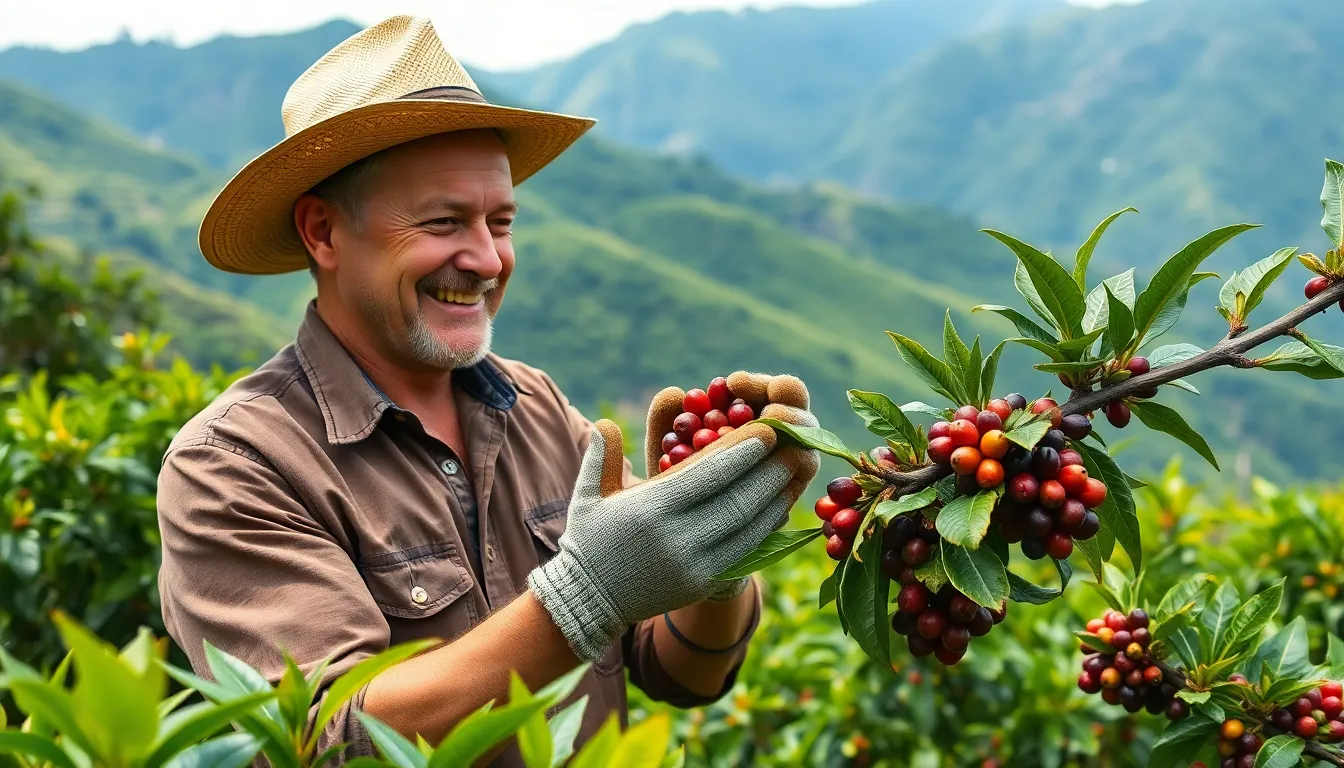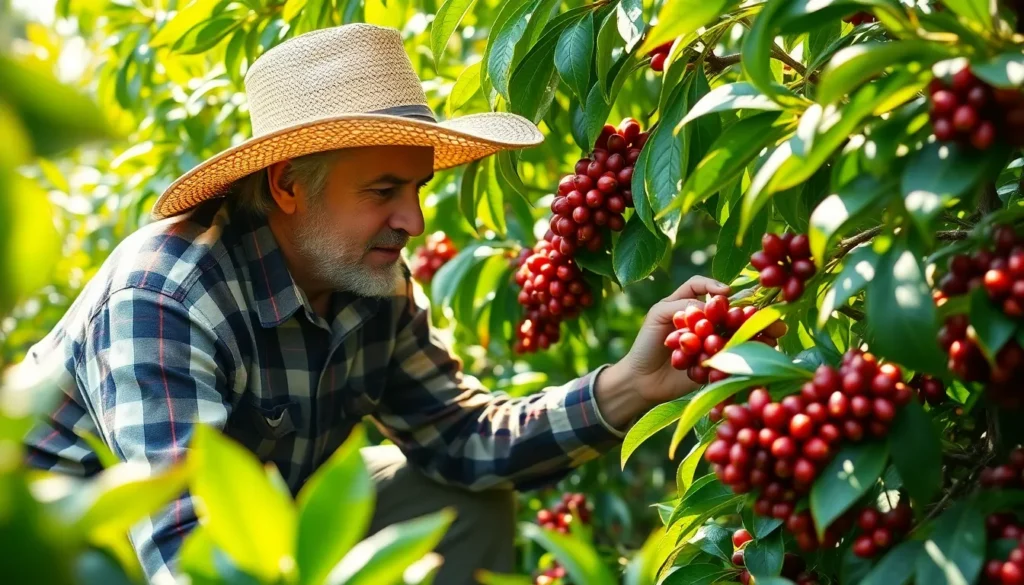Table of Contents
ToggleCoffee lovers often dream of the perfect brew, but few stop to consider the journey their beloved beans take from seed to cup. Coffee growth is a fascinating process that combines nature’s artistry with the science of agriculture. From lush plantations nestled in tropical climates to the meticulous care each plant receives, understanding how coffee grows can deepen appreciation for that morning ritual.
Overview of Coffee Growth
Coffee growth involves several key stages, each critical to producing high-quality beans. First, the journey begins with selecting the right coffee variety, such as Arabica or Robusta. These varieties differ in flavor profiles and growing conditions, impacting their cultivation requirements.
Next, soil preparation plays a crucial role. Ideal coffee-growing regions feature volcanic soil rich in nutrients. Farmers often analyze soil composition to ensure optimal growth, as this affects the overall health of the plants.
Climate significantly influences coffee growth. Coffee thrives in tropical regions with temperatures ranging from 60°F to 70°F, and it needs consistent rainfall, ideally between 40 to 100 inches annually. These conditions contribute to the proper ripening of coffee cherries.
Regular upkeep is vital for healthy coffee plants. This includes pruning to improve air circulation and reduce disease risk. Additionally, pest management ensures the plants remain disease-free, which is essential for yield quality.
Harvesting occurs when cherries turn a deep red, indicating ripeness. Picking methods vary, with hand-picking ensuring selective harvesting, while mechanical methods can increase efficiency in larger plantations.
Processing follows harvest, where beans undergo fermentation, washing, and drying. Each step impacts flavor and aroma, making it crucial to manage these processes carefully.
Coffee growth comprises intricate steps that transform seeds into beans, blending agricultural practices with climate considerations. Understanding these stages enhances appreciation for the craft behind every cup.
Factors Influencing Coffee Growth

Coffee growth is influenced by several key factors that shape the flavor and quality of the beans. Understanding these components can enhance appreciation for every cup.
Climate Conditions
Climate conditions play a crucial role in coffee growth. Optimal temperature ranges between 60°F and 70°F support healthy development. Regular rainfall, ideally between 40 inches and 100 inches annually, provides necessary moisture. Altitude also affects growth; elevations between 2,000 and 6,000 feet enhance flavor profiles. Temperature fluctuations during the day and night contribute to the beans’ maturation. Humidity levels around 70% promote thriving coffee plants. Precise climate conditions unique to specific regions contribute significantly to the diversity of flavors in coffee.
Soil Quality
Soil quality impacts coffee yields directly. Nutrient-rich volcanic soils are particularly beneficial for coffee cultivation. Mineral levels, such as nitrogen, phosphorus, and potassium, contribute to robust growth. Additionally, good drainage prevents waterlogging, which can hinder root development. Soils with a pH level between 6 and 6.5 create optimal conditions for absorption of nutrients. Regular soil testing ensures that specific nutrient deficiencies can be addressed. Properly prepared soil forms the foundation for healthy plants.
Agricultural Practices
Agricultural practices significantly enhance coffee growth outcomes. Effective pruning methods promote air circulation and sunlight penetration, essential for healthy plants. Sustainable pest management strategies reduce chemical usage and encourage biodiversity. Techniques such as shade-growing optimize soil moisture retention and provide a habitat for beneficial organisms. Fertilization schedules tailored to coffee varieties improve overall health and yield potential. Employing these practices results in higher quality and flavor in harvested beans. Attention to detail throughout these processes fosters a successful coffee-growing operation.
Coffee Growth Stages
Coffee growth comprises several distinct stages, each crucial for producing high-quality beans.
Germination
Germination begins when a coffee seed absorbs moisture, activating enzymes that kickstart the growth process. Within two to four weeks, the seed’s outer shell splits, revealing the seedling. Factors such as temperature and humidity significantly influence the speed of germination. Ideal temperatures range between 70°F and 85°F, while consistent moisture levels further improve success rates. During this initial phase, proper care is essential to foster healthy roots and prevent rot.
Seedling Development
Seedling development follows germination, marking a critical transition in coffee growth. Over the course of several months, seedlings develop leaves and roots that establish their foundation. At this stage, ideal conditions include warm temperatures and ample sunlight, ensuring robust growth. Leaves emerge in pairs, increasing photosynthesis and supporting energy production. During this period, care involves maintaining soil moisture and protecting seedlings from pests and diseases, promoting a strong start for future growth.
Flowering and Fruiting
Flowering and fruiting occur when coffee plants reach maturity, usually after three to four years. Flowers develop from leaf axils, releasing a sweet fragrance that attracts pollinators. Each flower yields a coffee cherry, which contains seeds that will eventually become coffee beans. Optimal conditions during this phase include temperatures between 60°F and 70°F, as well as adequate rainfall. Approximately seven to eight months after flowering, cherries ripen, changing color from green to red, signaling the time for harvest.
Common Coffee Growth Challenges
Coffee cultivation faces several challenges that can hinder growth and yield. Understanding these obstacles aids in developing effective solutions.
Pests and Diseases
Pests and diseases present significant threats to coffee plants. For instance, the coffee borer beetle reduces crop yields by infesting berries. Additionally, diseases such as leaf rust impact foliage health, impairing photosynthesis. Effective pest management strategies include integrated pest management practices that minimize chemical usage and focus on biological controls. Regular monitoring of plants can help detect early signs of infestations or disease. Implementing resistant coffee varieties can provide a long-term solution, as they withstand common threats more effectively.
Environmental Stress
Environmental stress factors affect coffee production significantly. Extreme temperatures, particularly above 80°F, can damage trees and reduce yields. Insufficient rainfall increases plant vulnerability, leading to drought stress that hinders growth. Changes in altitude further complicate cultivation, as specific coffee varieties thrive within particular elevation ranges. Implementing shade systems can mitigate temperature extremes while retaining soil moisture. Adopting water conservation techniques, such as drip irrigation, also enhances resilience against varying environmental conditions. These practices contribute to maintaining healthy coffee plants throughout their growth cycle.
The journey of coffee from seed to cup is a remarkable blend of nature and science. Understanding the complexities of coffee growth not only enhances appreciation for this beloved beverage but also highlights the dedication of farmers who cultivate it.
Every stage of coffee cultivation from soil preparation to harvesting plays a crucial role in shaping the final product. By recognizing the challenges faced in coffee farming and the innovative practices employed to overcome them, consumers can enjoy their daily cup with a newfound respect.
This deeper knowledge fosters a connection to the origins of coffee, making each sip a celebration of the art and effort behind its production.




